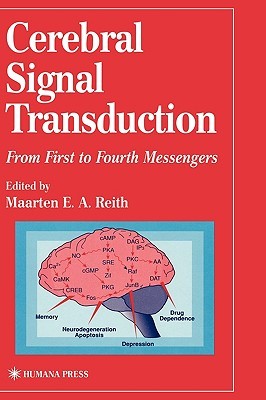
- We will send in 10–14 business days.
- Publisher: Humana
- ISBN-10: 0896036081
- ISBN-13: 9780896036086
- Format: 15.9 x 23.7 x 2.9 cm, hardcover
- Language: English
- SAVE -10% with code: EXTRA
Cerebral Signal Transduction (e-book) (used book) | bookbook.eu
Reviews
Description
Since the pioneering discovery of cyclic AMP four decades ago, a multitude of signaling pathways have been uncovered in which an extracellular signal (first messenger) impacts the cell surface, thereby triggering a cascade that ultimately acts on the cell nucleus. In each cascade the first messenger gives rise to the appearance of a second messenger such as cyclic AMP, cyclic GMP, or diacylglycerol, which in turn triggers a third messenger, a fourth messenger, and so forth. Many advances in elucidating such pathways have been made, including efforts to link messenger molecules to brain processes operative in health or disease. However, the latter type of information, relating signaling pathways to brain function, is scattered across a variety of publication media, which makes it difficult to integrate the multiple roles of different signaling cascades into our understanding of brain function in health and disease. The primary aim of Cerebral Signal Transduction: From First to Fourth Messengers, therefore, is to offer a comprehensive picture of the recent advances made in the signaling field as it relates to neuronal and cere- bral function. The current state of progress provides an exciting opportunity for such a comprehensive focus because molecular tools have become available to selectively remove, reduce, or enhance spe- cific components in the signaling pathways, e. g., by interfering with the genes encoding key proteins. In addition, the increased awareness of crosstalk between different signaling cascades has revealed many possibilities for changes in gene expression underlying long-term changes in brain function.
EXTRA 10 % discount with code: EXTRA
The promotion ends in 19d.14:44:57
The discount code is valid when purchasing from 10 €. Discounts do not stack.
- Publisher: Humana
- ISBN-10: 0896036081
- ISBN-13: 9780896036086
- Format: 15.9 x 23.7 x 2.9 cm, hardcover
- Language: English English
Since the pioneering discovery of cyclic AMP four decades ago, a multitude of signaling pathways have been uncovered in which an extracellular signal (first messenger) impacts the cell surface, thereby triggering a cascade that ultimately acts on the cell nucleus. In each cascade the first messenger gives rise to the appearance of a second messenger such as cyclic AMP, cyclic GMP, or diacylglycerol, which in turn triggers a third messenger, a fourth messenger, and so forth. Many advances in elucidating such pathways have been made, including efforts to link messenger molecules to brain processes operative in health or disease. However, the latter type of information, relating signaling pathways to brain function, is scattered across a variety of publication media, which makes it difficult to integrate the multiple roles of different signaling cascades into our understanding of brain function in health and disease. The primary aim of Cerebral Signal Transduction: From First to Fourth Messengers, therefore, is to offer a comprehensive picture of the recent advances made in the signaling field as it relates to neuronal and cere- bral function. The current state of progress provides an exciting opportunity for such a comprehensive focus because molecular tools have become available to selectively remove, reduce, or enhance spe- cific components in the signaling pathways, e. g., by interfering with the genes encoding key proteins. In addition, the increased awareness of crosstalk between different signaling cascades has revealed many possibilities for changes in gene expression underlying long-term changes in brain function.


Reviews